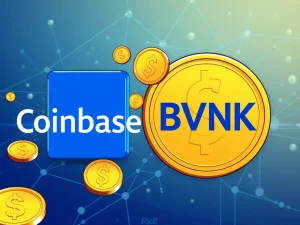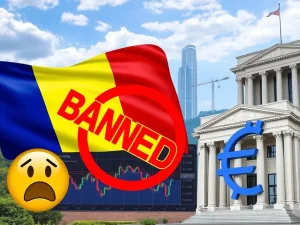Bitcoin’s Crucial Shift: Why Market Consolidation Signals a New Era for Digital Assets

Is Bitcoin’s current sideways movement more than just a lull? Macro analyst Jordi Visser offers a compelling perspective. He suggests Bitcoin is undergoing an ‘unofficial initial coin offering’ (ICO) or ‘initial public offering’ (IPO). This pivotal phase sees early holders rotating out, allowing new investors to acquire digital assets. This shift is distributing the supply across a broader base of participants, fundamentally altering Bitcoin’s market structure.
Jordi Visser’s Vision: Bitcoin’s Unofficial IPO
Jordi Visser, a seasoned macro analyst and Wall Street veteran, recently shared a fascinating insight. He believes **Bitcoin** is currently in the midst of an ‘unofficial IPO.’ This analogy draws parallels between Bitcoin’s market behavior and the traditional process of a company going public. During this period, original coin holders are steadily moving their dormant assets. Meanwhile, a fresh wave of investors is stepping in, actively accumulating tokens on market dips. This dynamic redistribution is crucial for the asset’s long-term health.
Visser articulated this view on Anthony Pompliano’s podcast and in a Substack post. He observed that old coins, which have remained untouched for years, are now on the move. He noted, “Not all at once. Not in panic. But steadily.” Simultaneously, new investors are actively “accumulating on dips.” This pattern signifies a fundamental change in ownership. In the traditional financial world, an IPO marks the moment when early believers realize their gains. Founders become wealthy, and venture capitalists return capital to their limited partners. Bitcoin’s current phase mirrors this process in the digital realm.
“The excitement of concentration is being replaced by the durability of distribution,” Visser explained. “The early believers are passing the torch to long-term holders who bought at higher prices and have different motivations. This is what success looks like. This is Bitcoin having its IPO.” This perspective highlights a maturation of the **digital assets** market. It moves from early, concentrated ownership to a more fragmented, robust distribution.

Market Consolidation: A Natural Post-IPO Phase
Currently, **Bitcoin** (BTC) has been trading sideways. Its price has fluctuated between approximately $106,786 and $115,957 over the past week. Visser argues that this **market consolidation** is a typical occurrence after a company goes public. Early investors often begin to sell their positions. This selling pressure can lead to the stock consolidating, even when broader markets are rallying. It is a necessary phase for price discovery and new ownership to stabilize.
New investors are indeed acquiring Bitcoin, but they are proceeding with caution. They often wait for the distribution among a broader market to complete before becoming more aggressive. “The result? A sideways grind that drives everyone crazy,” Visser stated. “The fundamentals are fine. The broader market is rallying. But the stock just… sits there.” This period can be frustrating for many. Sentiment often dips during such consolidation phases. However, it serves a critical purpose.
Visser further elaborated on this phenomenon. “This is the exact pattern you see after a major IPO when lock-up periods expire. The stock doesn’t crash. It consolidates. Early investors sell. New long-term holders accumulate. Ownership transfers from the visionaries to the institutions.” Therefore, this seemingly stagnant period is not a sign of weakness. Instead, it indicates a healthy, albeit often tedious, transfer of ownership. It solidifies Bitcoin’s foundation for future growth and broader acceptance.
Underlying Faith and Robust Crypto Adoption Indicators
Despite the sideways price action and prevalent market sentiment, Visser maintains that faith in the underlying asset remains strong. The Crypto Fear & Greed Index, a key indicator of market sentiment, has shown “fear” ratings recently. However, this sentiment often lags behind fundamental developments. Visser points to several crucial indicators that underscore Bitcoin’s resilience and growing **crypto adoption**:
- **Ongoing Exchange-Traded Fund (ETF) Approvals:** These approvals signify increasing institutional acceptance and provide regulated avenues for traditional investors to gain exposure to Bitcoin. They bring legitimacy and liquidity to the market.
- **Bitcoin Network Hashrate Hitting New Highs:** A rising hashrate indicates a stronger, more secure network. Miners are investing more resources into validating transactions, which reinforces the network’s integrity and robustness.
- **Growing Stablecoin Adoption:** The increasing use of stablecoins reflects broader utility and liquidity within the crypto ecosystem. Stablecoins facilitate trading, remittances, and decentralized finance, driving further engagement with digital assets.
Visser contrasts this with a bear market scenario. “In a bear market, there are no buyers. Price collapses because everyone wants out and nobody wants in,” he noted. “But look at what’s actually happening: Bitcoin is consolidating, not collapsing. Every dip gets bought. The price isn’t making new lows, it’s holding a range.” This distinction is vital. It highlights accumulation rather than capitulation. The divergence from traditional risk assets might seem confusing. However, the fundamentals of Bitcoin are stronger than ever. The structural shift from concentrated to fragmented holdings is precisely what Bitcoin needs to transition from a revolutionary experiment to a durable monetary asset.

The Ongoing Journey of Bitcoin’s IPO Process
This “IPO” phase for **Bitcoin** is likely to continue for some time. Visser estimates that such processes typically last between six to eighteen months in traditional markets. While Bitcoin’s market often moves at an accelerated pace compared to conventional assets, the current phase is still relatively early, approximately six months into this timeline. Investors should therefore anticipate this period of **market consolidation** to persist.
When this phase concludes, one significant outcome will likely be reduced price volatility. As ownership becomes distributed among a much larger number of participants, the influence of any single large holder diminishes. This fragmentation creates a more stable and resilient market. It reduces the impact of large sell-offs by early holders or founders. This enhanced stability is crucial for attracting even wider **crypto adoption** from institutional and retail investors alike.
“For now, expect continued consolidation. Expect Bitcoin to keep frustrating people by not rallying with risk assets,” Visser advised. “Expect the sentiment to remain poor for a little while longer but be wary because there will be no signal. It will just start because the good news is already present.” This implies that the underlying positive developments are already in motion. The market is simply undergoing a necessary rebalancing. Therefore, investors should focus on the long-term structural changes rather than short-term price movements. This perspective is vital for understanding the evolution of **digital assets**.
Broader Implications for the Future of Digital Assets
The successful completion of this “IPO” phase holds profound implications for the future of **digital assets**. This transition from a concentrated asset to a widely distributed one is a critical step in Bitcoin’s journey. It moves from being a speculative, revolutionary experiment to a durable, recognized monetary asset. This maturation process is essential for its long-term viability and its role in the global financial landscape. A more distributed ownership base enhances decentralization. It also reduces potential points of failure or manipulation, bolstering trust and security.
Furthermore, the increased stability resulting from this broader distribution will pave the way for more significant institutional involvement. Corporations, sovereign wealth funds, and other large-scale investors require a certain level of predictability and liquidity. The reduction in extreme volatility will make Bitcoin a more attractive and manageable asset for these entities. This, in turn, will accelerate mainstream **crypto adoption** and integration into traditional financial systems. Ultimately, this period of **market consolidation** is not merely a pause. It is a fundamental transformation, setting the stage for Bitcoin’s next major growth cycle. This crucial shift will redefine its position as a cornerstone of the future financial ecosystem.
Editor’s Choice MEV driving institutions away from DeFi, costing users dearly: Crypto exec Bitcoin starts $100K ‘capitulation’ as BTC price metric sees big volatility China officially hates stablecoins, DBS trades Bitcoin options: Asia Express Bitcoin ends ‘Uptober’ in the red, BNB activity spikes: October in charts Crypto’s changing demographics demand a new approach to crypto security Advertise with us









